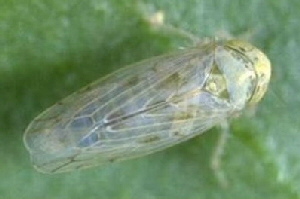Beet Leafhopper
 Scientific Name
Scientific Name
Circulifer tenellus
Host
Adults may land and probe-feed on many different plants, but generally prefer to lay eggs on beets, tomatoes and various weeds.
Symptoms
Adults and nymphs have piercing sucking mouthparts which they use to remove plant nutrients from leaves and stems of host plants. When abundant, adult and nymph feeding can result in shriveled and burned leaves, which is generally referred to as 'hopper bum'. However, the main damage caused by the leafhopper is from a pathogen vectored by adults. Adult leafhoppers transmit the curly top virus from plant to plant. The virus causes tomato and potato plant leaves to turn yellow in color, to curl and often have a purple color associated with the leaf veins and stems. Plants do not grow, the stems become stiff and plants remain stunted. Generally the fruit on the plant ripens prematurely and are deformed.
Life Cycle
Adults move into fields in early spring and lay eggs on suitable hosts. Eggs hatch, and nymphs develop to adults in 2 to 3 months. There may be multiple generations in Oklahoma.
Description
The adult is a small wedge-shaped insect, is pale green to yellow in color with darker blotches and approximately 1/8 inch long. The adults have long slender rear legs and will jump or fly away when disturbed. Adults move into fields in early spring and feed on plants, often moving when suitable hosts are not located.
Control
Please contact your local county extension office for current information.

